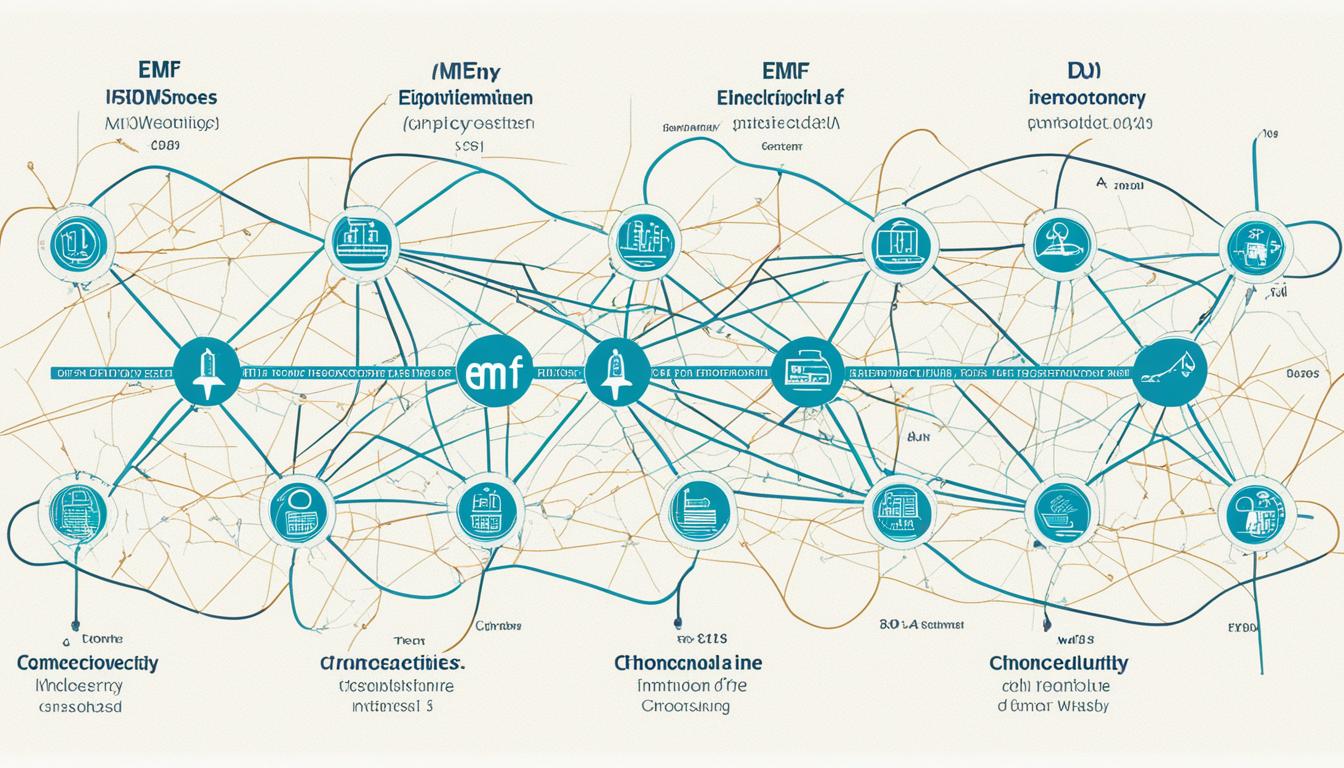Disclosure: This Post Contains Affiliate Links; We earn a commission on purchases.
Welcome to our comprehensive guide on electromagnetic fields (EMFs). In this article, we’ll delve into the nature, significance, and basics of EMFs, shedding light on their definition, importance, effects, and ongoing research. Let’s explore the fascinating world of EMFs and their potential impact on our lives.
Key Takeaways:
- EMFs, a combination of electrical and magnetic fields, are created wherever electricity is generated, transmitted, or used.
- Electric fields are measured in volts per meter (V/m), while magnetic fields are measured in tesla (T) or microtesla (µT).
- Exposure to artificial EMFs has raised concerns about possible biological effects, prompting ongoing research by various organizations.
- Natural and artificial EMFs can both have biological effects, but the intensity and duration of exposure to artificial EMFs are generally lower.
- The biological effects of EMFs include oxidative stress, cellular damage, DNA damage, and potential links to cancer.
Types of Electromagnetic Fields
In the world around us, electromagnetic fields (EMFs) can be classified into two broad categories: natural electromagnetic fields and artificial electromagnetic fields. Both types of EMFs have the potential to affect biological systems in various ways.
Natural Electromagnetic Fields
Natural electromagnetic fields are generated by natural phenomena and living organisms. Some examples of natural EMFs include:
- Thunderstorms: Lightning during thunderstorms produces strong electromagnetic fields.
- Earth’s Magnetic Field: The Earth itself generates a magnetic field, which is crucial for navigation and orientation in many species.
- Living Organisms: Living organisms, including humans, generate weak electrical fields due to biological processes such as nerve impulses and muscle contractions.
These natural EMFs have existed since the inception of our planet and play essential roles in the functioning and development of biological systems.
Artificial Electromagnetic Fields
Artificial electromagnetic fields, on the other hand, are created by human-made technologies. These technologies include:
- Electrical Wiring: The electrical wiring used in homes, buildings, and infrastructure produces artificial EMFs.
- Electronic Devices: Devices such as computers, televisions, and smartphones emit artificial electromagnetic fields.
- Telecommunications: Cell towers, Wi-Fi routers, and other communication technologies generate artificial EMFs.
Artificial EMFs have become increasingly prevalent with the advancement of technology and the widespread use of electronic devices. While their intensity and duration of exposure are generally lower than natural EMFs, they can still have biological effects on living organisms.
Biological Effects of EMFs
Both natural and artificial electromagnetic fields have the potential to impact biological systems. Research studies have indicated that exposure to artificial EMFs can lead to various biological effects, including alterations in biomolecules, DNA and protein damage, and decreased reproduction.
These findings have raised concerns about the potential health risks associated with long-term exposure to artificial EMFs. While research is still ongoing, it is important to recognize the potential effects of artificial EMFs and take appropriate measures to minimize exposure.
Biological Effects of EMFs
Exposure to artificial electromagnetic fields (EMFs) poses various health risks, including the potential for oxidative stress, cellular damage, DNA damage, and even cancer. These risks are particularly associated with specific types of EMFs, such as radio frequency (RF), microwave, and extremely low frequencies (ELF).
Studies have revealed that artificial EMFs can induce significant changes in biomolecule synthesis and inflict damage on DNA and proteins within living organisms. These effects can have profound consequences, ranging from cell death to reduced reproduction and the development of cancer.
Although the intensity and duration of exposure to artificial EMFs are generally lower than those of natural EMFs, their biological action is attributed to their polarization. Unlike natural EMFs, artificially polarized EMFs have the ability to force oscillations in charged molecules within biological tissues, giving rise to harmful biological effects.
Impact of EMFs on Cellular Health
Growing evidence has linked exposure to artificial EMFs to oxidative stress, an imbalance between the production of free radicals and the body’s antioxidant defenses. This imbalance can lead to cellular damage and impair the normal functioning of cells and tissues.
| Biological Effect | Description |
|---|---|
| Oxidative Stress | Exposure to artificial EMFs increases the production of free radicals, overwhelming the body’s antioxidant capacity. This oxidative stress can damage cellular components, including proteins, lipids, and DNA. |
| Cellular Damage | The accumulation of oxidative stress caused by EMFs can lead to cellular dysfunction and structural damage. This may result in impaired cellular communication and compromised overall cellular health. |
| DNA Damage | EMFs have been shown to induce DNA strand breaks and other genetic alterations. These changes can disrupt normal cell division and increase the risk of mutations, potentially leading to the development of cancer. |
| Cancer | While the direct causal relationship between EMFs and cancer is still being studied, exposure to artificial EMFs has been associated with an increased risk of certain cancers, including brain tumors and childhood leukemia. |
It is crucial to mitigate the potential health risks associated with EMF exposure and continue researching methods for EMF protection. By understanding the biological effects of EMFs, we can take necessary steps to minimize exposure and protect our cellular health.

Natural vs. Artificial EMFs: Understanding the Differences
When it comes to electromagnetic fields (EMFs), understanding the differences between natural and artificial sources is crucial. Not only do they vary in their biological effects, but they also differ in their polarization.
Natural EMFs are not polarized and align with the natural oscillations and orientations of particles. These EMFs are generated by thunderstorms, the Earth’s magnetic field, and even living organisms. Natural EMFs have existed since the dawn of time and have played a significant role in the evolution and development of organisms.
On the other hand, artificial EMFs are polarized and do not follow the natural patterns of oscillation and orientation. They are generated by man-made technologies, including electrical wiring, electronic devices, and telecommunications systems. The polarization of artificial EMFs can cause interference in living tissue, making the body more susceptible to their biological effects.
| Natural EMFs | Artificial EMFs |
|---|---|
| Not polarized | Polarized |
| Align with natural oscillations and orientations | Do not align with natural patterns |
| Promote evolution and development of organisms | Can cause interference in living tissue |
The imbalance of charges in artificially polarized EMFs can lead to harmful biological effects. Unlike natural EMFs, the polarized nature of artificial EMFs disrupts the preferred oscillations and orientations of particles in biological tissue.
At Noxtak, our dedicated research and development team is focused on repolarizing artificial EMFs to reduce their potential harmful effects on biological systems.
By understanding the differences between natural and artificial EMFs, we can better comprehend their contrasting impacts on living organisms and work towards creating a healthier environment for all.

Conclusion
Understanding the nature and significance of electromagnetic fields (EMFs) is crucial for addressing the potential health risks associated with exposure. EMFs are present everywhere in our environment, both naturally and from man-made technologies, making it important to take measures to protect ourselves.
Artificial EMFs have been linked to various biological effects, including oxidative stress, cellular damage, and DNA damage. The differences in polarization between natural and artificial EMFs contribute to the harmful biological effects of artificial EMFs. Therefore, ongoing research and development are vital to finding effective solutions.
To mitigate the potential health risks of EMF exposure, implementing proper EMF protection techniques and accurate EMF measurement are essential. By employing these measures, we can minimize exposure and create a safer environment. Continued EMF research will further contribute to our understanding and enable the development of more advanced protection techniques.
Source Links
- https://noxtak.com/natural-vs-artificial-electromagnetic-fields-the-importance-of-polarization-2/
- https://www.ehs.iastate.edu/sites/default/files/uploads/publications/manuals/emf.pdf
- https://www.ncbi.nlm.nih.gov/pmc/articles/PMC6025786/

Subscribe to Our Newsletter










